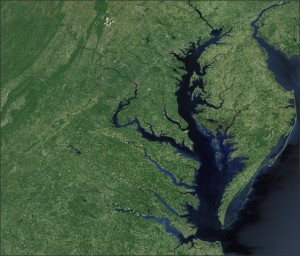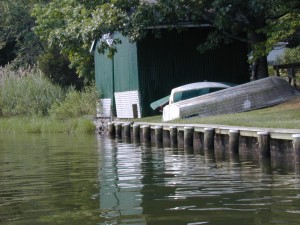If the Chesapeake Bay could drive, it would have a severe case of road rage. The nation’s largest estuary is stressed out. That’s putting it mildly.

The Chesapeake Bay Watershed. Landsat imagery courtesy of NASA Goddard Space Flight Center and U.S. Geological Survey.
Nutrient runoff, shoreline development and invasive species are just a few of the factors contributing to the Chesapeake Bay’s poor health. For decades, scientists at the Smithsonian Environmental Research Center (SERC) have been teasing out how these “stressors” impact the Bay’s plants and animals. A new $5 million grant from the National Oceanic and Atmospheric Administration (NOAA) will help bolster their efforts.
The NOAA grant comes at a time when President Barack Obama has renewed efforts to protect the Chesapeake. Last May, Obama issued The Chesapeake Bay Protection and Restoration Executive Order. The research that SERC scientists will undertake can be directly applied to new policy and management efforts.
The “multiple stressors” study began in October and will continue for five years. SERC is leading the interdisciplinary team of 17 scientists from seven institutions. The group will set up field studies throughout the Chesapeake. They’ll collect a vast array of data on everything from underwater vegetation to shorebirds; from water quality to land use. Armed with an extensive body of information, scientists will build a comprehensive and nuanced picture of the Bay’s stressors.

Scientists will study how erosion control structures - like the bulkheads shown here - affect underwater grasses. Photo: Alicia C. Young
The study’s scientific discoveries will have real-world applications. In fact, the Maryland Department of Natural Resources (MD-DNR) informed many of the research questions. The investigations will produce tools to help them model and predict the impact of different ecological and land-use scenarios. John Griffin, secretary of MD-DNR, says he expects this project to “provide the practical information for driving wetland restoration and managing development in Maryland’s critical areas.”
SERC senior scientist Tom Jordan will lead the team of 17 investigators. Jordan has studied the flow of nutrients into the Bay for more than two decades. He finds comfort in large data sets – the more variables, the better. “We know that the shallow water habitats of Chesapeake Bay are suffering, but the Bay is such a large and complicated system,” he says. Five years from now, Jordan expects to have a more complete understanding of how the estuary works.
If the team can figure out how to relieve just some of the Bay’s stresses, perhaps someday the estuary will conjure metaphors of relaxed retirees driving RVs in the right lane.
Return to SERC’s home page.


Hey, I am new . This Websites great, ive learned a lot from it so far!